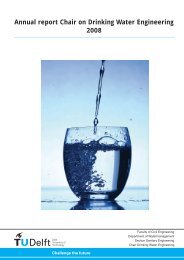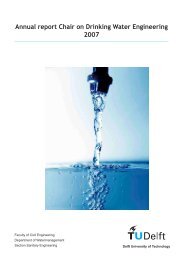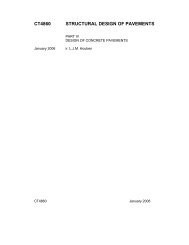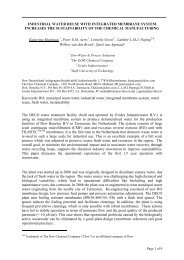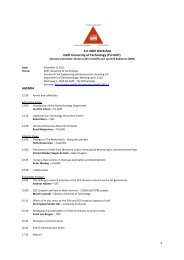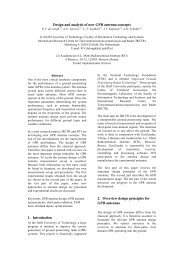Lecture Notes CT 4860 Structural Pavement Design Design of ...
Lecture Notes CT 4860 Structural Pavement Design Design of ...
Lecture Notes CT 4860 Structural Pavement Design Design of ...
You also want an ePaper? Increase the reach of your titles
YUMPU automatically turns print PDFs into web optimized ePapers that Google loves.
example <strong>of</strong> the problems one encountered in the early years <strong>of</strong> motorization. In those days most<br />
roads were earth or gravel roads and the strength <strong>of</strong> the pavement solely depended on the shear<br />
strength <strong>of</strong> the materials used.<br />
Figure 14: <strong>Pavement</strong> problem in the<br />
early years <strong>of</strong> motorization.<br />
One has to realize that nowadays about 65% <strong>of</strong> the global road network still consists <strong>of</strong> earth<br />
and gravel roads. Problems as shown in figure 14 therefore still quite <strong>of</strong>ten occur as is shown in<br />
figure 15.<br />
Figure 15: Timber truck completely<br />
stuck on an earth road due to too<br />
high contact pressures and a too low<br />
shear resistance <strong>of</strong> the pavement<br />
material.<br />
In both cases it is clear that the stresses induced in the pavement are higher than the allowable<br />
ones resulting in shear failure <strong>of</strong> the pavement surface and resulting in the fact that in both cases<br />
the vehicle got “stuck in the mud”. The question now is why a light vehicle, such as shown in<br />
figure 14, suffered from the same problems as the heavy vehicle shown in figure 15. This has to<br />
do with the fact that the contact pressures caused by the light vehicle shown in figure 14 are <strong>of</strong><br />
the same order <strong>of</strong> magnitude as the contact pressures caused by the heavy vehicle shown in<br />
figure 15. The lesson we learn from this is that it is not really the weight <strong>of</strong> the vehicle that is <strong>of</strong><br />
importance or the number <strong>of</strong> axles but the contact pressure distribution under the tires. This<br />
distribution not only depends on the wheel load but also on the area over which the wheel load is<br />
distributed. This depends to a very large extent on the tire pressure. In the old days, solid tires<br />
were initially used and when pneumatic tires were introduced, high tire pressures had to be used<br />
because <strong>of</strong> the size <strong>of</strong> the tire (see figure 14). This resulted in small contact areas and high<br />
contact pressures (as comparison: the contact pressure under the tire <strong>of</strong> a race bicycle is high<br />
because these tires are inflated to 700 kPa pressure; the contact area is also small). All this<br />
means that the contact pressure due to the vehicle shown in figure 14 could very well be the<br />
same as the contact pressure due to the vehicle shown in figure 15. Therefore similar types <strong>of</strong><br />
surface defects can be expected.<br />
12



